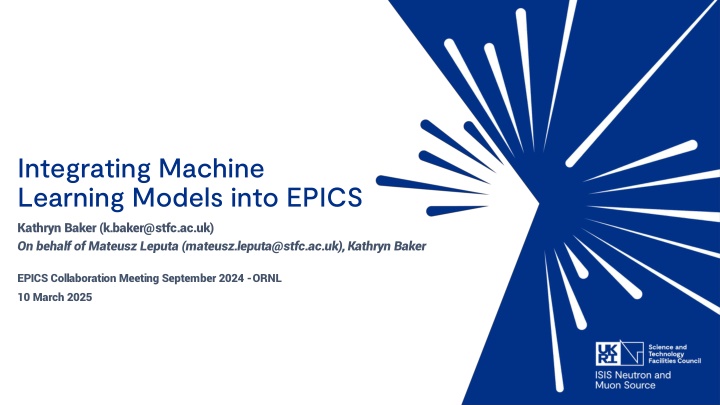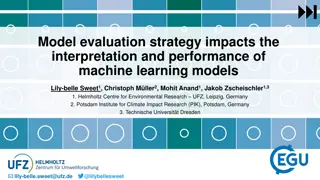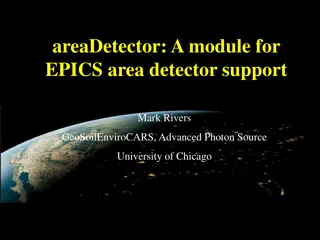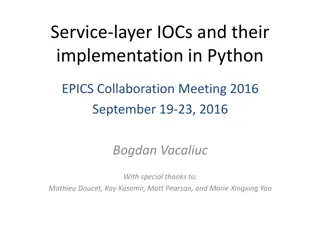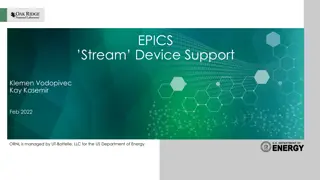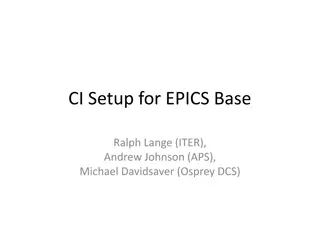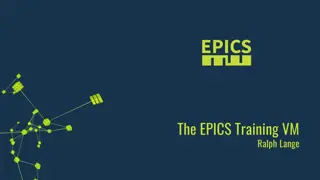Integrating Machine Learning Models into EPICS Overview
This overview discusses the integration of machine learning models into EPICS, detailing the motivations, previous approaches, current solution with Lume-deployment, repeatability, results, and future work. It also highlights the benefits such as creation of virtual components, offline testing, integration with existing tools, operator training opportunities, and easier interface management.
Download Presentation

Please find below an Image/Link to download the presentation.
The content on the website is provided AS IS for your information and personal use only. It may not be sold, licensed, or shared on other websites without obtaining consent from the author.If you encounter any issues during the download, it is possible that the publisher has removed the file from their server.
You are allowed to download the files provided on this website for personal or commercial use, subject to the condition that they are used lawfully. All files are the property of their respective owners.
The content on the website is provided AS IS for your information and personal use only. It may not be sold, licensed, or shared on other websites without obtaining consent from the author.
E N D
Presentation Transcript
Integrating Machine Learning Models into EPICS Kathryn Baker (k.baker@stfc.ac.uk) On behalf of Mateusz Leputa (mateusz.leputa@stfc.ac.uk), Kathryn Baker EPICS Collaboration Meeting September 2024 -ORNL 10 March 2025
Overview 1. Why ML in EPICS? 2. What did we do before? 3. Current Solution 4. Lume-deployment Overview 5. Repeatability with cookiecutter 6. Results 7. Future Work
Why Integrate ML Models into EPICS? Creation of virtual components Offline interface testing Offline application testing Integrates with existing tools Display using Phoebus, CS Studio, PyDM Out of the box archiving (if required) Offline operator training opportunities Fewer Interfaces to manage
What did we do Before? training deployment A previous iteration of our deployment pipeline used TorchServe to deploy individual models as HTTP endpoints within our Docker swarm. EPICS PVA Servers then needed to be coded by the developer to send and receive updates from this model as EPICS PVs (also deployed as Docker containers)
What did we do Before? training Repeated, complex, multi-step code deployment This resulted in multiple stages of deployment and repeated code across projects with the PVA Servers being written slightly different depending on the developer (see yesterday s talk on standardising p4p servers).
Current Solution lume-deployment training Templated, containerised code deployment Lume-deployment was developed by Mateusz Leputa while on secondment at SLAC working with Jesse Bellister and Auralee Edelen. It is designed to integrate with the LUME environment developed and in use at SLAC. https://github.com/MatInGit/lume-deployment
Current Solution lume-deployment training Templated, containerised code deployment Lume-deployment* resolves a lot of the repetition in code by handling required model transformations, additional computation and serving of EPICS PVs into a Python CLI program with easy integration for MLFlow and local models https://github.com/MatInGit/lume-deployment
lume-deployment: Design Overview Lume-deployment is designed to work in a variety of cases depending on your level of interaction with your machine Read/write Case 1: Reinforcement Learning Case 2: Anomaly Detection, Model quality monitoring Read only Case 3: Surrogate Isolated Model
lume-deployment: Key Components Transformer*takes your data from data source units to units used to train the NN and can perform simple calculations *NOTE class name may change!* Interface collates data from your data source e.g. EPICS, Tango, files and passes it to the transformer. Custom Interface allows you to create a PVA Server using p4p to host your PVs (case 2 and 3) Model is used to interact with the trained neural network. The General model passes and returns dictionaries while the Inference model handles tensors. Both can be used to make additional calculations on top of inputs or outputs.
lume-deployment: Key Components Configuration of Interfaces and Transformers is defined in a `pv_mapping.yml` file. Found during use that there was a lot of repetition in how you use the deployment, particularly for complex models. In each case, you had to write the same boilerplate python scripts and yaml files. As users, we wanted automation and templating!
lume-deployment: Repeatability with cookiecutter User runs: cookiecutter local/path/to/template/repo User provides: Folder name Model_name and model_version Experiment name and run ID (mlflow)
lume-deployment: Repeatability with cookiecutter Developer then follows steps from README: 1. fill in the inference.py file 2. run the upload.py file with the appropriate flags to store the model in mlflow (if desired) 3. Use generated docker- compose files to deploy locally or in production
lume-deployment: Repeatability with cookiecutter Developer then follows steps from README: 1. fill in the inference.py file 2. run the upload.py file with the appropriate flags to store the model in mlflow (if desired) 3. Use generated docker- compose files to deploy locally or in production
lume-deployment: Repeatability Developer then follows steps from README: 1. fill in the inference.py file 2. run the upload.py file with the appropriate flags to store the model in mlflow (if desired) 3. Use generated docker- compose files to deploy locally or in production
lume-deployment: Repeatability Developer then follows steps from README: 1. fill in the inference.py file 2. run the upload.py file with the appropriate flags to store the model in mlflow (if desired) 3. Use generated docker- compose files to deploy locally or in production
lume-deployment: Results 3 surrogate models (case 3) deployed to EPICS within 1 week
Future Work Testing of Case 2 models (anomaly detection / model performance tracking) Additional Transformers (e.g. time series) Automating re-deployment of models with CI/CD E.g. on update of version number in Docker Compose Possibly automating re-deploying on push of new MLFlow version? Link with p4p for ISIS to allow more functionality for p4p servers (e.g. control limits, alarm limits etc Extending interfaces (e.g. HTTP, Kafka, File Types)
Thank you! Any questions?
